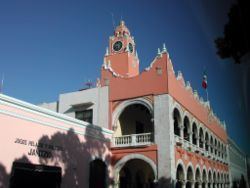Mexico Ind. 1821 Municipality Est 1918 Area 883.4 km² Area code 999 | State Yucatán Yucatán Est. 1824 Elevation 9 m (30 ft) | |
 | ||
Destinations Mérida, Sotuta de Peón, Dzibilchaltún, Dzityá, Komchen, Xcanatún, Chablekal, Tixcacal, La Ceiba, Caucel Clubs and Teams Venados F.C., Leones de Yucatán Points of interest Parque Zoológico del Cente, St Ildephonsus Cathedral, Parque Zoológico Animaya, Museo Fernando García Po, Paseo de Montejo Colleges and Universities Universidad Autónoma de Yucatán, Anahuac Mayab University, Instituto Tecnológico de Mérida | ||
Mérida Municipality is one of the 106 municipalities in the Mexican state of Yucatán containing (858.41 km2) of land with the head or seat being the city of Mérida. Because the archaeological remains of the Maya reminded the Spaniards of the ancient city of Mérida, Spain, which was marked by Roman archaeological sites, they renamed the site of T-hó after the Spanish city.
Contents
- Map of MC3A9rida YucatC3A1n Mexico
- History
- Governance
- Geography and climate
- Communities
- Local festivals
- Tourist attractions
- References
Map of M%C3%A9rida, Yucat%C3%A1n, Mexico
History
What now constitutes the head of the municipality of Mérida, was a pre-Hispanic Itza Mayan town called T-hó (In the Yucatec Maya Language: “five hills”), which was founded around the 12th century AD. By the time of the Spanish arrival, the city was virtually abandoned, though still used as a ceremonial center and its remnant buildings were of impressive monumental scale. Francisco de Montejo the Younger established the city of Mérida on the site on 6 January, 1542. In the first year of the conquest, Montejo ordered the establishment of 54 encomiendas in favor of his soldiers and confirmed the three principal municipalities to be Mérida, Valladolid, and San Francisco de Campeche.
Overlapping jurisdictions occurred for the area at various times with the administration being under the Audiencia de Guatemala in 1549, but also the Viceroyalty of New Spain from 1549-1552. Then between 1552 and 1561 the area returned to the Audiencia de Guatemala and between 1561 and 1565 was again administered under the Viceroyalty of New Spain. In 1617, Yucatán became a Captaincy General in its own stead.
Yucatán declared its independence from the Spanish Crown in 1821 and in 1825, the area was distributed into 15 administrative partitions including Bacalar, Campeche, Hecelchakán, Hunucmá, Ichmul, Isla del Carmen, Izamal, Lerma, Mama, Mérida, Oxkutzcab, Seibaplaya, Sotuta, Tizimín and Valladolid. In 1840, Yucatán declared itself to be a free, independent nation with its capital located in Mérida. The following year treaties were signed for the peninsula to rejoin Mexico, but by 1842, independence was again declared. In 1843, a new treaty of reinstatement was signed, but in 1845 the peninsula withdrew because Mexico had not complied with the terms of the 1843 agreement. Finally in 1846 the peninsula agreed to reintegrate into Mexico but the outbreak of the Caste War, in 1847, an indigenous rebellion that took place throughout the Yucatán, delayed the full implementation until 1849.
The Constitution of 1850, redrafted the administrative divisions and made headquarters for the 17 partitions at: Bacalar, Bolonchenticul, Campeche, Espita, Hequelchakan, Isla del Carmen, Izamal, Maxcanú, Mérida, Motul, Peto, Seibaplaya, Sotuta, Tekax, Ticul, Tizimin, and Valladolid. In 1918, the modern municipality of Mérida was confirmed as the seat of the municipio and capital of the State.
Governance
The municipal president is elected for a three-year term. The town council has seventeen councilpersons, who serve as Secretary and councilors of Markets, Utilities and Public Safety; Administration; Social Development; Public Security; Entertainment; Urban Development and Ecology; Public Works; Youth And Sports; Women; Health and Disability; Economic Development; Tourism; Heritage; Education; and Culture.
The Municipal Council administers the business of the municipality. It is responsible for budgeting and expenditures and producing all required reports for all branches of the municipal administration. Annually it determines educational standards for schools.
The Police Commissioners ensure public order and safety. They are tasked with enforcing regulations, distributing materials and administering rulings of general compliance issued by the council.
Geography and climate
The land throughout the municipality is virtually flat, without any areas of the elevation, and like much of the Yucatan Peninsula has no surface water streams. There are cenotes both underground and at the surface (collapsed caverns). The climate is semi-humid, with temperature range between a maximum of 40 °C and minimum 14 °C.
Communities
The head of the municipality is Mérida, Yucatán. There are 158 populated areas of the municipality. The most notable include Caucel, Chablekal, Cholul, Chuburná de Hidalgo, Cosgaya, Dzityá, Dzununcán, Komchén, Molas, San José Tzal, Sierra Papacal and Sitpach. Communities of 50 people or more (as of 2005) are listed below, along with numerous smaller ones (not listed).
Local festivals
Every year on 6 January the founding of the city is acknowledged in a city-wide festival. Also annually from 27 September to 14 October is a celebration in honor of Santo Cristo de las Ampollas.
